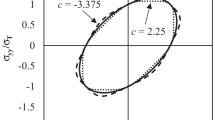Abstract
An elastic-plastic analysis is performed for an infinite plate under plane stress conditions which contains a finite line crack and is subjected to biaxial loading. In the large scale yielding range, the amplitude of the dominant singularity at the crack tip, the plastic stress (or strain) intensity factor, is found to depend on the magnitude of loading parallel to the crack direction. The predicted value for the fracture initiation stress which is based on a plastic intensity factor fracture criterion, increases under lateral, tensile loading. Compressive loading parallel to the crack has the opposite effect on the fracture initiation stress.
Résumé
On procède à une analyse élastoplastique du cas d'une tôle infinie en conditions d'état plan de tension, qui comporte une fissure linéaire finie et qui est sujette à une mise en charge biaxiale.
Dans le domaine des grandes déformations plastiques, on a trouvé que l'amplitude de la singularité dominante à la pointe de la fissure—à savoir le facteur d'intensité des contraintes (ou des déformations) plastiques—dépen de l'importance de la charge parallèle à la direction de la fissure.
Le niveau de contrainte que l'on prédit conduire à l'amorçage de la rupture, et qui est basé sur un critère de rupture relevant du facteur d'intensité plastique, s'accroît en présence de charges de traction latérales.
Une mise en charge par compression, parallèlement à la fissure, a un effet inverse sur la contrainte d'amorçage de la rupture.
Zusammenfassung
Man untersucht im elastoplastischen Gebiet den Fall eines unendlichen Bleches, im ebenen Spannungszustand, mit einem endlichen linearen Riß, der biaxial belastet wird.
Im Gebiet der großen plastischen Verformungen hat man gefunden daß die Amplitude der überwiegenden Sonderbarkeit an der Spitze des Risses und zwar der plastische Spannungsintensitätsfaktor (oder Dehnung) von der Größe der Belastung parallel zur Richtung des Risses abhängt.
Der vorausgesetzte Wert der bruchauslösenden Spannung die sich auf einem plastischen Bruchintensitätsfaktor Kriterium gründet, nimmt zu mit der seitlichen Zugbelastung.
Druckbelastung parallel zum Riß hat einen entgegengesetzten Einfluß auf die bruchauslösende Spannung.
Similar content being viewed by others
References
J. W. Hutchinson, Singular Behavior at the End of a Tensile Crack in a Hardening Material, Journal of Mechanics and Physics of Solids, 16 (1968) 13–31.
J. R. Rice, and G. Rosengren, Plane Strain Deformation Near a Crack Tip in a Hardening Material, Journal of Mechanics and Physics of Solids, 16 (1968) 1–12.
P. D. Hilton, and J. W. Hutchinson, Plastic Intensity Factors for Cracked Plates, Journal of Engineering Fracture Mechanics, (to be published).
J. J. Kibler, and R. Roberts, The Effect of Biaxial Stresses on Fatigue and Fracture, Transactions of the ASME, Journal of Engineering for Industry (to be published).
J. D. Eshelby, The Force on an Elastic Singularity, Phil. Trans. Royal Society of London, Series A, 244, (1951) 87–112.
B. Budiansky, Extension of Michell's Theorem to Problems of Plasticity, 16 (1958) 307–309.
Author information
Authors and Affiliations
Rights and permissions
About this article
Cite this article
Hilton, P.D. Plastic intensity factors for cracked plates subjected to biaxial loading. Int J Fract 9, 149–156 (1973). https://doi.org/10.1007/BF00041857
Received:
Issue Date:
DOI: https://doi.org/10.1007/BF00041857




